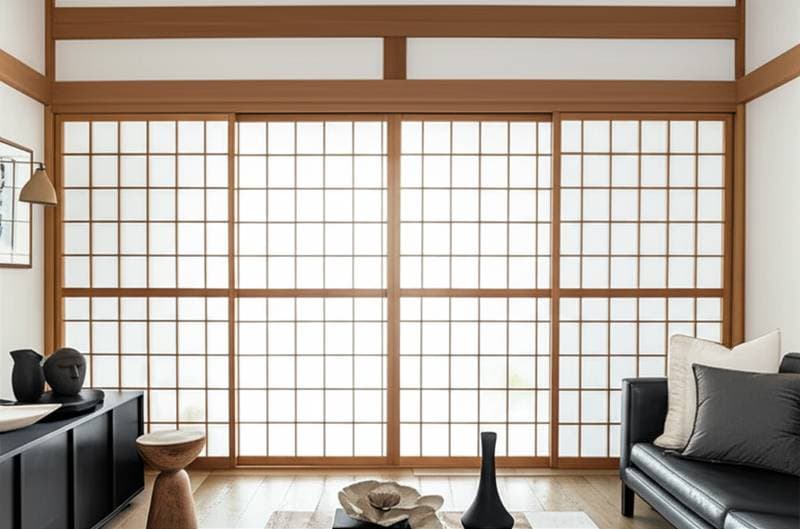Shoji Doors: A Timeless Element for Minimalist Interiors in 2025
Soft light filters through translucent panels, clean lines guide the eye, and sliding mechanisms ensure seamless transitions. Shoji doors, rooted in Japanese architecture, now enhance modern homes with their calming presence. These doors balance privacy and openness, save space, and introduce natural warmth to minimalist designs.
Homeowners value simplicity that avoids sterility. Shoji doors achieve this through their lattice frames and light-diffusing inserts, fitting seamlessly into contemporary, Scandinavian, or Japandi styles. They reduce visual clutter, promote flow between rooms, and offer enduring appeal over fleeting trends.
Approaches to Incorporating Shoji Doors
Budget-Friendly Option ($500 to $1,500)
- Opt for prefabricated panels featuring lightweight wood frames and synthetic rice paper.
- Install on surface-mounted tracks to minimize alterations to existing structures.
- Select high-quality gliding hardware to ensure smooth operation and durability.
Mid-Range Option ($1,500 to $3,000)
- Choose custom-sized panels with solid pine or maple frames and laminated shoji paper.
- Use recessed tracks for a flush, integrated appearance.
- Pair with brushed nickel or matte black handles for modern cohesion.
Premium Option ($3,000 to $6,000)
- Commission hardwood systems in oak, walnut, or ash with intricate lattice designs.
- Incorporate tempered glass or reinforced inserts for clarity and resistance to damage.
- Add built-in lighting or framing details to accentuate wood grain.
Selecting Materials and Finishes
For windows, select narrow muntins or black aluminum frames; frosted glass extends the shoji theme indoors. Doors benefit from natural tones like birch or walnut; black-stained frames provide contrast against pale walls. Outdoors, vertical siding in neutrals such as warm white or driftwood gray maintains continuity.
Trim requires minimalist profiles and hidden hardware. Match wall paints or stains to door frames for unity. These choices ensure the design feels intentional and harmonious.
Essential Maintenance Practices
Delicate materials demand gentle care. Synthetic or laminated panels resist tears better than traditional rice paper, which avoids moisture. Dust surfaces with a microfiber cloth; steer clear of abrasives to prevent scratches on acrylic.
Condition wood frames periodically with natural oils. In humid areas, use dehumidifiers to avoid warping. For kitchens or bathrooms, select vinyl-backed or glass alternatives against steam.
Clean tracks regularly with a brush or vacuum to sustain smooth movement. Proper initial alignment minimizes ongoing issues.
Common Pitfalls to Avoid
- Select simple lattice patterns to prevent overwhelming small areas and maximize light flow.
- Position doors where light travels between rooms; dark spaces diminish their effect.
- Seal frames thoroughly to guard against moisture-induced warping.
- Invest in reliable tracks to eliminate sticking and ensure effortless use.
Enhancing Spaces with Shoji Doors
Minimalism evolves to include warmth alongside restraint. Shoji doors soften harsh lines, diffuse light gently, and pair well with natural elements like stone or linen. They address open-plan challenges by providing subtle division, sound filtering, and preserved openness.
The wooden grid adds texture that shifts with daylight, fostering a curated rather than sparse environment.
Integration Ideas by Room
Entryway ($800 to $2,000)
- Swap solid doors for sliding shoji panels to introduce welcoming light.
- Use warm woods with woven rugs or simple benches.
- Incorporate storage behind panels for tidiness.
Living Areas ($1,200 to $3,000)
- Divide living and dining zones with double panels for connected yet defined spaces.
- Choose wide formats to elongate rooms visually.
- Employ ceiling tracks for a sleek, elevated look.
Bedrooms ($2,000 to $4,000)
- Partition closets or bathrooms with frosted acrylic for privacy.
- Align with neutral bedding in ivory or taupe.
- Maintain serenity through coordinated soft furnishings.
Durable Materials for Varied Climates
Light woods like birch suit dry regions; darker walnut endures humidity when sealed. Bamboo provides an eco-friendly hardwood substitute.
Traditional rice paper offers authenticity but requires protection; synthetics add resilience. Acrylic panels withstand traffic and pets while preserving translucency.
Hardware in brushed nickel or stainless steel resists corrosion in coastal settings.
Coordinating Colors and Styles
Restrained palettes enhance cohesion:
- Soft neutrals: Warm white walls, pale oak doors, sand textiles, black accents.
- Monochrome: Light gray walls, black frames, stone floors.
- Earth tones: Clay walls, honey wood, beige curtains.
- Coastal: Fog gray exteriors, bleached trim, frosted panels.
- Zen modern: Olive walls, walnut frames, brass details.
Focus on repetition and simplicity to achieve harmony.
In humid climates, control moisture to prevent swelling. Coastal homes need salt-resistant seals. Arid areas benefit from wood oils against cracking. Cold regions pair panels with insulating layers for warmth. Routine cleaning involves soft cloths and mild soap as needed; replacements remain straightforward.
Extending the Design Influence
Shoji elements extend to exteriors through siding patterns or window grilles that echo interior rhythms. Tempered glass versions for sliding doors blend indoor-outdoor views while upholding privacy.
Unified detailing on mullions or garage doors ties the facade to serene interiors, boosting overall appeal.
Achieving Cohesive Implementation
Document light patterns, measure openings, and assess climate before proceeding. Align budgets with priorities like hardware or materials.
Shoji doors elevate daily life through functional elegance. Coordinate tones, finishes, and architecture thoughtfully to integrate them seamlessly. This approach yields serene, adaptable spaces that endure.






